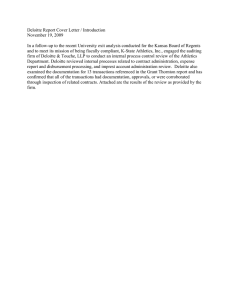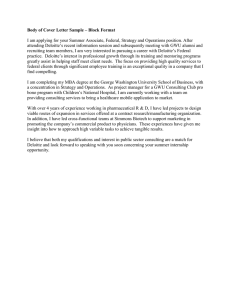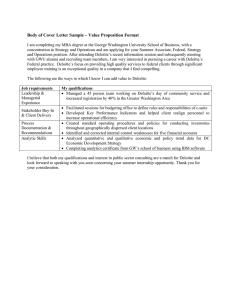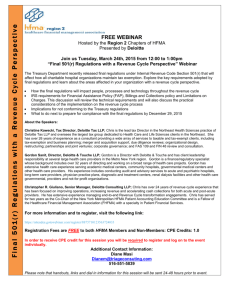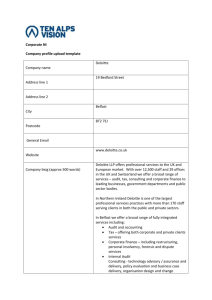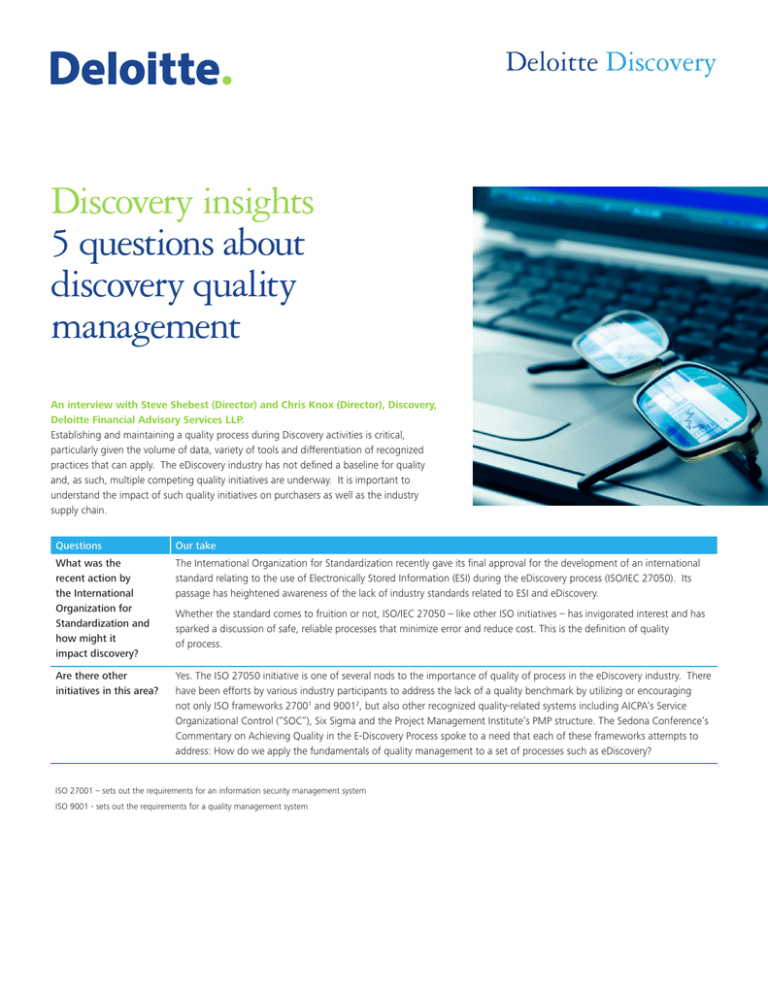
Deloitte Discovery
Discovery insights
5 questions about
discovery quality
management
An interview with Steve Shebest (Director) and Chris Knox (Director), Discovery,
Deloitte Financial Advisory Services LLP.
Establishing and maintaining a quality process during Discovery activities is critical,
particularly given the volume of data, variety of tools and differentiation of recognized
practices that can apply. The eDiscovery industry has not defined a baseline for quality
and, as such, multiple competing quality initiatives are underway. It is important to
understand the impact of such quality initiatives on purchasers as well as the industry
supply chain.
Questions
Our take
What was the
recent action by
the International
Organization for
Standardization and
how might it
impact discovery?
The International Organization for Standardization recently gave its final approval for the development of an international
standard relating to the use of Electronically Stored Information (ESI) during the eDiscovery process (ISO/IEC 27050). Its
passage has heightened awareness of the lack of industry standards related to ESI and eDiscovery.
Are there other
initiatives in this area?
Yes. The ISO 27050 initiative is one of several nods to the importance of quality of process in the eDiscovery industry. There
have been efforts by various industry participants to address the lack of a quality benchmark by utilizing or encouraging
not only ISO frameworks 27001 and 90012, but also other recognized quality-related systems including AICPA’s Service
Organizational Control (“SOC”), Six Sigma and the Project Management Institute’s PMP structure. The Sedona Conference’s
Commentary on Achieving Quality in the E-Discovery Process spoke to a need that each of these frameworks attempts to
address: How do we apply the fundamentals of quality management to a set of processes such as eDiscovery?
Whether the standard comes to fruition or not, ISO/IEC 27050 – like other ISO initiatives – has invigorated interest and has
sparked a discussion of safe, reliable processes that minimize error and reduce cost. This is the definition of quality
of process.
ISO 27001 – sets out the requirements for an information security management system
ISO 9001 - sets out the requirements for a quality management system
Questions
Our take
How do the
fundamentals of
quality management
apply to electronic
discovery?
Quality management requires a systematic approach to quality assurance, control and improvement. Quality assurance
(“QA”) means having checks in place to ensure each of your processes are executed correctly. Quality control (“QC”)
validates the quality assurance effort by measuring the end result of your processes. Quality improvement, particularly
continuous quality improvement, is the discipline of taking the variance from your expected results found either at the QA
or QC stages and revising the appropriate process to minimize that risk of variance moving forward.
How do you attack variance of process? Galileo is credited with admonishing us to count what is countable, measure
what is measurable, and to make measurable that which isn’t already measurable. Likewise, Peter Drucker suggested
that if you can’t measure it, you can’t manage it. Six Sigma’s DMAIC framework proposes that we Define, Measure,
Analyze, Improve and then Control. There is a theme here worth acknowledging. For example, how do you know that the
document reviewers understand the coding manual if you don’t audit their coding, particularly right after the training? Is
one contract attorney moving significantly slower through the review sets due to a lack of effort or being stuck with 30-tab
excel spreadsheets or very large files that take minutes for each to load to the review pane? Does each document in your
production set coded as “redacted” actually have a redaction applied somewhere? Do your “exception” documents really
constitute a valid exception or was there a correctable issue with processing? How accurate are your search terms and how
many “false positives” are they generating, resulting in additional review cost?
All of the various means to measure and identify outliers or variances from expectations will ideally roll up into a
documented process for overall quality management. All of the systems and frameworks mentioned above are means to
the end of framing that quality of process.
How have providers
of discovery services
sought to distinguish
themselves within the
quality environment?
The electronic discovery service provider market is a fractured one, with local, regional, national and global players. Further,
providers differ in the scope of offered services across the spectrum from identification and collection, to processing and
hosting to document review. Finally, providers utilize different technological tools with varying capabilities and limitations.
All of this can contribute to an array of different risks and experiences for the same basic set of discovery requirements.
Due to the fractured marketplace and lack of an industry benchmark, service providers have sought to differentiate
themselves in numerous ways, many of them related to quality. Some have achieved quality of process through audit
regimen and/or certification in other areas, e.g. ISO 9001 or AICPA SOC 2. Others have endeavored to bolster their
commitment to quality by ensuring that project personnel have a grounding or certification in a relevant discipline such
as Six Sigma or the Project Management Institute’s PMP. Finally, others have eschewed formal frameworks but built in
rigorous quality audits such as statistical sampling to verify processes.
Questions
Our take
In the absence of an
existing, independent
benchmark for quality
of process, what
actions can a purchaser
of discovery services
take to proactively
manage the quality of
electronic discovery
obligations?
When vetting a service provider, ask the tough questions related to their Quality Management processes. For example, you
may want to determine:
• If the provider has a documented plan in place to assure quality during each phase of collection, processing, review and
production
• If their approach is largely reactive, based just on the sampling of final results or more proactive through quality checks
built into each sub-process
• How often, if at all, are their processes audited and by whom
• If gaps or deficiencies identified by audit or internal checks are rolled into any form of continuous improvement discipline
• If the provider can demonstrate documented management commitment to quality throughout the organization
• What metrics the provider can share with respect to the any of the quality measures they have in place.
Finally, even after you have selected your provider, consider applying a disciplined audit of the resulting work product. Have
a plan tied to either your existing internal approaches to quality or expectations and previous pain points related to the
eDiscovery process.
Our take: Quality management is something that can, and should, begin at home as the industry matures and promulgates objective
benchmarks for measuring the practices, partners and protocols of the discovery process.
The recent developments on the international stage serve to underline not only the importance of understanding the fundamentals of quality
management but also having a plan in place prior to entering the discovery process. As John Ruskin once said, “quality is never an accident; it is
always the result of intelligent effort.” As the cost and intricacy of discovery of electronically stored information increases, the need for consistency and
defensibility of process does as well. Working with your discovery team to understand how they are managing quality is a critical, yet often overlooked,
key to success.
Contact
For more information, please contact:
Steve Shebest
Director, Discovery
Deloitte Financial Advisory Services LLP
+1 202 220 2631
sshebest@deloitte.com
Chris Knox
Director, Discovery
Deloitte Financial Advisory Services LLP
+1 512 498 7411
csknox@deloitte.com
This publication contains general information only and Deloitte is not, by means of this publication, rendering accounting, business, financial, investment, legal, tax, or other professional
advice or services. This publication is not a substitute for such professional advice or services, nor should it be used as a basis for any decision or action that may affect your business.
Before making any decision or taking any action that may affect your business, you should consult a qualified professional advisor. Deloitte shall not be responsible for any loss sustained
by any person who relies on this publication.
About Deloitte
As used in this document, "Deloitte" means Deloitte Financial Advisory Services LLP, a subsidiary of Deloitte LLP. Please see www.deloitte.com/us/about for a detailed description of the
legal structure of Deloitte LLP and its subsidiaries. Certain services may not be available to attest clients under the rules and regulations of public accounting.
As a non-legal service provider, Deloitte’s discovery services are provided under the direction and supervision of its client’s legal counsel.
Copyright © 2013 Deloitte Development LLC. All rights reserved.
Member of Deloitte Touche Tohmatsu Limited


